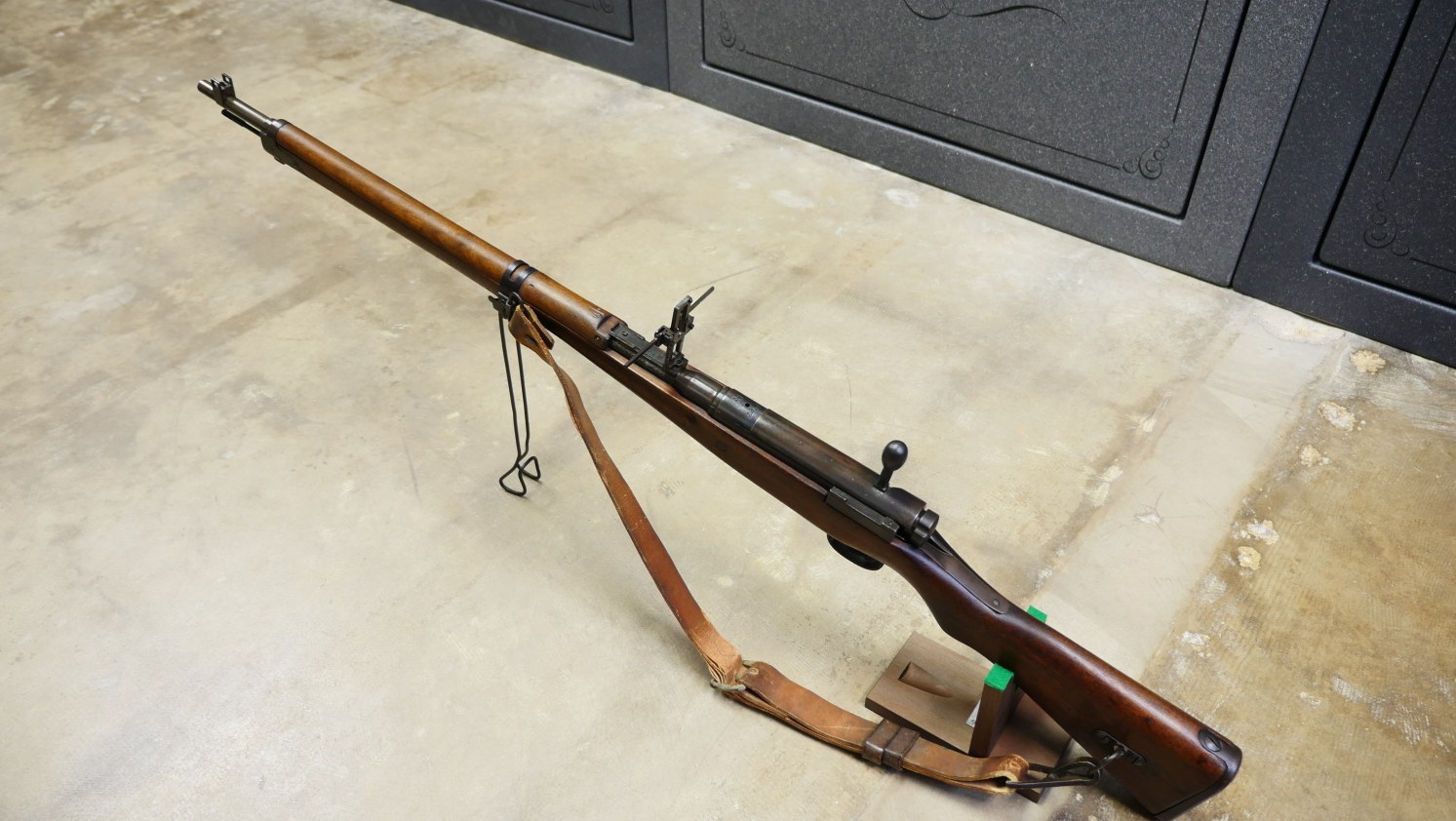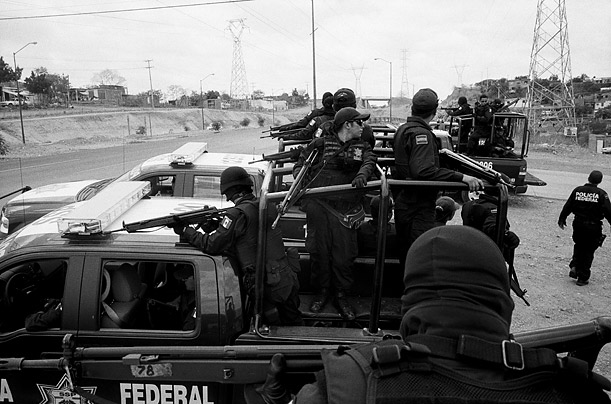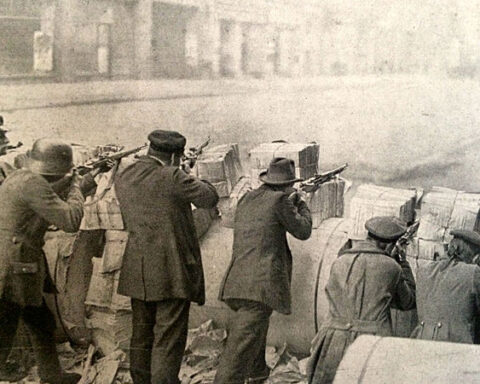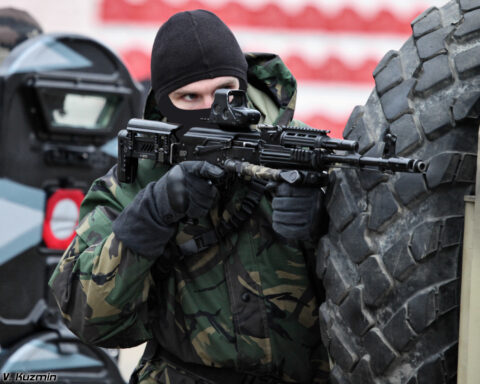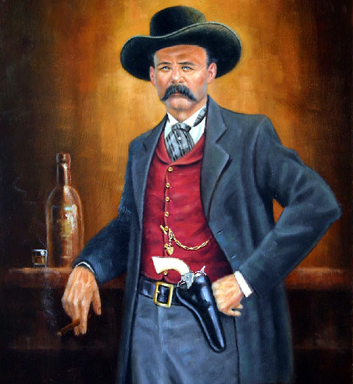Editor’s note: The following is extracted from Shots Fired in Anger: A Rifleman’s-Eye View of the Activities on the Island of Guadalcanal, by Lt. Col. John B. George (published 1947).
The Model 1939 7.7mm Rifles
After a few weeks in battle in jungle areas most any Infantry man will admit that he cannot possibly tell the exact caliber or type of rifle from its report alone. He will generally say that any bullet coming over at short range will crack like a whip as it passes, and that the crack will become less sharp and less loud as the range increases. But he will also tell you that the primary sound of the rifle (the actual muzzle blast) can seldom be considered a giveaway as to the caliber of an enemy weapon. Terrain surroundings do much to alter the sounds of weapons; acoustics in the jungle and coconut groves are treacherous.
When different calibered weapons are being fired, side by side, on the range, the difference in sound, even though the calibers and charges are nearly the same, will be noticeable. And on the range the same is true of various Japanese weapons. We all knew that the 6.5mm cartridge always made a sharp crack in the rifle; thin and piping, compared to the deeper roar of an M1 or an ’03, whether it was fired from a carbine or rifle. But this difference was distinguishable only in the open, or in areas where the fighting had been fixed for a while and the sounds of certain weapons had been heard over and over again in that area so that they were cataloged clearly, each in the soldier’s mind. After several day’s fighting in the same set of holes it would generally be possible to determine the caliber and distance of a weapon from its report alone.
On the third day after the Second Battalion had taken Mount Austen, it was reported by many men along the outer line that they were being fired at with our own M1 rifles, and a few ’03s too. I was almost certain that the Japs had not gotten more than four of our rifles during the previous fighting; the men we had lost during the early hours had been covered pretty well by artillery fire during the first night and the Japs did not get to their bodies. But in the shooting going on all along the line, we had recognized a louder and deeper series of reports, which indicated that at least thirty enemy rifles of caliber larger than 6.5mm were being used.
The new weapons were heard first at about nine o’clock, and as I gradually became aware of the meaning of those different sounds, I began to suffer from a gnawing fear that the unit we were pitted against had been reinforced during the night by other troops — armed with a different weapon. It was not the greatest fear I was feeling at the time, because there were other things to worry about, and I didn’t tell anyone of it; though the new firing sounds were being discussed all along the perimeter.
While I was nibbling away at a can of meat and beans, and cursing the QM for accepting rations in a style of can which could absolutely not be opened without a third of its contents being spilled over the poor soldier’s lap, a Japanese rifleman, who had infiltrated around our right flank, started potting away. Not with any great effect — but he scared some men down at the water hole into taking cover, and he also got a part of the CP on the slope pinned down. I got my rifle and went stalking him, getting a somewhat better idea of his location after each of his shots.
I had sited myself on that part of the slope which he had under fire, and I was kneeling behind a big fallen log which did not give any too much protection because it was rotten and pithy inside. I knew it wouldn’t stop a bullet, and that concern tended to hamper my concentration upon the difficult problem of locating the infiltrator’s position. But I had to make the most of it, and get underway as quickly as possible, as one good rifleman in such a position can raise merry hell with the people he is shooting at. There was no safe place to conduct the search from which would give me the good view of my present position. So I continued the search, hoping with sincere earnestness that I would find the Nip before he located me.
My efforts were forestalled — fortunately not by the Nip. I had just begun to get my bearings when a bunch of people over in “F” Company, to my left flank and above me on top of the hill, began to open up on the base of a large buttress-rooted tree. I instantly aimed with my rifle at a spot on one of the great flattened roots, where the burst of their Browning Automatic rifle had centered itself, tearing away at the bark and splattering the green moss crust. Something fell from the top of that root, where it joined the trunk, and then the slumped form of a Jap, with a tightly strapped helmet still hanging on his head, slid down along the upper edge of the root. His shoulders, head, arms and hands were hanging down on my side. As he slid on downward someone in “F” Company continued to let him have it with the BAR, so that when he came to rest at the bottom of the root he was churned up into a reddish mess — but that helmet, shot through several times, remained on his head. He had evidently followed the creed of the ancient Samurai warrior and “tightened his helmet strings for the battle.”
The object which first fell from the higher part of the root had been the soldier’s rifle — one of the new ones which had just been heard for a few hours, a Model 99 (1939) 7.7mm job, official successor to the Arisaka 6.5mm. I got hold of it a day later, in rather good shape, with only a few flakes of rust on the outside. The Jap’s body had fallen clear of the rifle and the rust was of the ordinary type, not the deep, pitted corrosion which is caused when a weapon is wetted with salty blood.
From first glance it looked to me as though the decision to adopt this new Japanese rifle as the standard Infantry weapon must have been made on a level above Infantry command circles, for except in the interests of caliber standardization, the weapon had little to offer in the way of advantages over the older 6.5mm caliber weapons.
The older guns were easier to shoot, having much less recoil; their ammunition was light to carry; and the carbine model of the Arisaka 6.5mm was much lighter and handier in the jungle. And the ballistic qualities of the old 6.5 were entirely adequate for mankilling.
The Japanese knew all of this, and while they had decided to adopt the heavier calibered weapon they did not do it in whole-hog fashion. They simply began to manufacture it along with their other weapons, and to gradually increase its quantities in the field. I was to learn of this later on in the war, though the trend was indicated pretty well by what we were to see on Guadalcanal itself.
This first 7.7 rifle I looked at was nearly new, and the varnish finish and light color of wood used in the stock were considerable handicaps to camouflage in the jungle. This complaint held true for all Japanese weapons, though — all of them used the same sort of light colored and unduly porous wood, which would not take an oil finish at all. Like other Japanese rifles, the new 7.7mm job was blued in finish; that was the only finish I saw on enemy weapons on Guadalcanal. The Japs apparently did not use the parkerizing finish at all, and with the glossy blue and varnished stock they used this weapon tended to reflect lots of light — entirely too much for a military rifle.
The M99 can be described as a rather ordinary military rifle, weighing 9 pounds, with an overall length of 44 1/2 inches and a barrel length of 25 1/2 inches. It has a monopod (which could be called a bipod, as it has two prongs) front support which folds forward from the lower band; this is about 12 inches long. It retains the same type bolt and receiver, and nearly the same type of action as the M38 Arisaka. Differences in these parts are very minor, such as the adoption of a “cocking piece” of slightly different shape from the Arisaka, although its function as safety lock remained the same. The rear end of the receiver bearing against the rear of the bolt handle base was altered, apparently in the interest of manufacturers’ shortcuts. It was lighter and thinner than the M38s. The length of the receiver extension piece on top was increased so that its rearmost tip was nearly back to the point of comb — a full three-and-a-half inches from the rear of the receiver proper. This permitted the rear guard screw to actually be placed through the stock behind the pistolgrip, and enabled the weak wood of the grip to be reinforced by inletting steel straps on top and below. It would seem that the rigorous program for bayonet practice must have broken quite a few stocks to cause this precautionary measure.

Backward steps were taken in the design of a plain spring-loaded ejector, and the employment of a hole drilled at twelve o’clock in the receiver ring for a gas vent. The bolt itself had the usual large oval gas vent cut just in front of the extractor collar cut. The ubiquitous Jap action cover was stubbornly retained, God knows why.
Viewing the action from the underside, other changes in the old Arisaka design could be seen. A hinged floorplate had been adopted with the hinge forward; and a new type latch was employed at the rear, with its operating portion mostly inside the trigger guard; a rearward pull on a small up-bent protrusion being necessary to unlock the floorplate. The guard was extended far rearward to match the increased length of the receiver extension above, giving the entire guard and floorplate assembly an overall length of 11 inches. The extended rear part was bent to fit the outline of the slightly curved pistolgrip into which it inletted. All three guard screws were inserted from the under side.
The sling swivels were fitted on the left side of the rifle, possibly a compromise measure, as it was planned to use the one length of weapon for both Infantry and Cavalry. The buttplate was of the shallow, stamped metal-cap variety, extended forward at the top so that its upper screw could be inserted downward at right angles to the one in the heel.
The lower band was more massive than any yet seen, and was held in place by a through bolt, which did away with the excessive weight of the two spring retainers used on the Arisaka. The band’s under portion swelled into a solid block which provided a base and hinge for the heavy wire monopod. Its left side held the upper sling swivel, the loop of which was lopsided to assume a comfortable position, or “bearing angle” of the sling on the carrying shoulder.
Some slight economy of weight was evident in the construction of the upper band. It was still amply strong, but lacked the heaviness of the one on the Cavalry carbine. A full-length cleaning rod was set in the forend and retained by means of a push button latch; this latch was built lighter in weight than the one used on the Arisaka and the Thirty Year Model. The visible parts of it were small, just an inletted guide with a square push button about an inch-and-a-quarter behind the band.
A handguard was employed to cover the top of the barrel from rear sight base to the upper band, different from those on the Arisaka rifles, which went forward only to the lower band leaving the barrel beyond that point bare on top. This new procedure permitted the upper band to be placed in the normal position, to hold the sling swivel, instead of in the far forward position to bind the far end of the handguard. (The far-out position of lower band, so used on the Arisaka, made carrying very awkward, causing the far dangling lower part of the rifle to bang uncomfortably against the thigh and hip of the carrier.)
The front sight was on exactly the same pattern as the Arisaka, a barleycorn blade dovetailed into a base with side guards. The base had a good flat front to give a surface for the bayonet guard to rest against — a practical field sight, but not built for good all- round accuracy.
In the rear sight of the M99 rifle, though, the Japanese did themselves proud, trying out several new (to them) ideas at the same time. The sight was mounted in the same place as on previous weapons, an inch-and-a-half forward of the receiver, but its construction was different from any other Japanese rifle. The only retained feature was the basic folding-leaf design; practically every other concept followed in the case of the Arisaka was discarded.
They adopted the peep sight, and went for it whole-hog. Even the battle sight was a peep. At the same time, they left off the earlier ideas of short range zero; where all previous rifles had minimum settings of 400 meters, the M99 had provision for zeroing at 100 meters; and the battle peep, which came into position when the main sight leaf was laid, was apparently zeroed for point blank firing. Both regular and battle apertures were made large enough, each measuring roughly 3/32″, but like our own ’03, they were positioned too far from the eye for optical correctness. The leaf was of the conventional type, and no windage adjustment was provided in its base. Ranges were laid off by scored lines from 100 to 1,500 meters, odd numbers on the left standard, even numbers on the right. Designating numerals were provided from “3” on up, the lower lines being too close together to allow room for the figures “1” and “2.”
The elevation slide was moved by depressing two spring-loaded levers located at opposite sides on the top of the slide. When so depressed, the bottom inward edge of each lever would disengage itself from its side of the leaf and the slide could be raised or lowered to change the elevation. A notch was provided on one or the other side for each hundred yards of range. There was no provision for adjustment to intermediate ranges, nor was there any provision for shifting the position of the aperture within the body of the slide, either laterally or vertically.
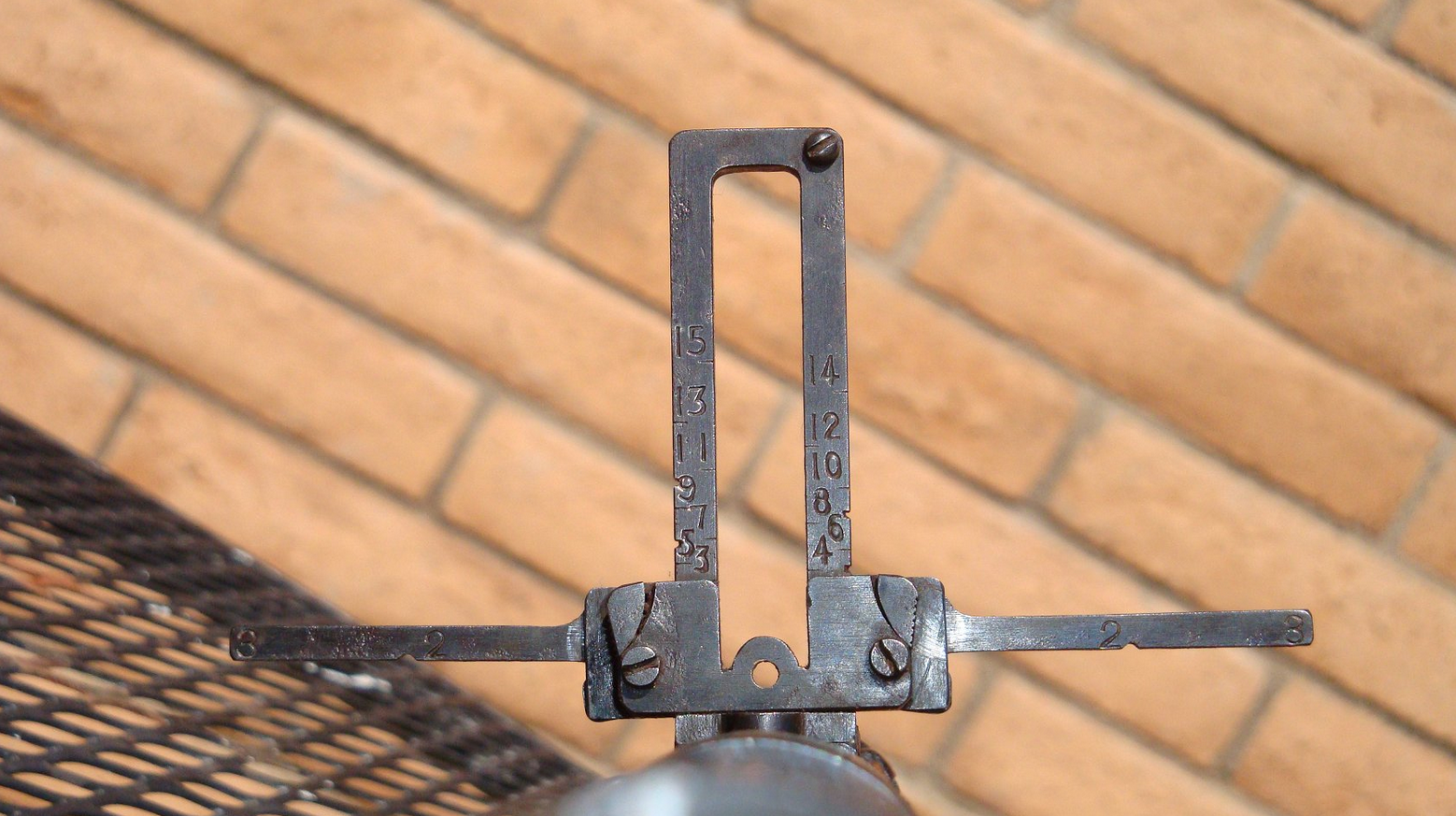
The rear sight contained a fantastic innovation in the form of a pair of horizontally jutting scaled markers which were part of the rear sight assembly, attached to the slide. Each one, when folded down from the upraised leaf, projected outward an inch-and-a-half, making the overall width of the rear sight measure some four-and-seven-eighths inches. Apparently these devices were for anti-aircraft fire, to calculate very long leads. Each one was scored at center and end with the numbers “2” and “3,” each numbered from the inside out (i.e., the “2s” closest to the sight leaf proper).
With all the gadgets in operating position — the monopod down, the sight leaf up, and the right and left anti-aircraft lead scales folded outward — the weapon had a truly weird appearance; the sight looking like a cross with a low lateral member. Add a bayonet and it looked like some highly complicated hari kari machine.
But with all the fun we can poke at it, the weapon did indicate a trend toward improvement in Japanese ordnance design. It retained a lot of the good features of the Mauser-fathered Arisaka, such as the neat bolt disassembly system and the improved bolt stop arrangement. The adaptation of aperture sights was also an improvement. There was some proof that the Japanese had profited from their early jungle experience — given by the provisions for precise short range zero in the new rifle, the first one of a long line that did not require holding under at short range.
The weapon had been evolved from the Arisaka .25 with the simultaneous purposes of standardizing calibers and providing a larger bore diameter to permit the use of properly-designed and effective tracer and armor-piercing bullets. As a gun it compared favorably with the better military rifles of Europe, being better than some models. It was, of course, a very crude item when compared to our Springfield. When compared to our Garand it was utterly obsolete, and its use against that weapon placed the Japs at an enormous combat disadvantage.
But the 7.7mm Model 99 rifle is numbered among the weapons which killed a lot of Americans in World War II and therefore it deserves a certain amount of respect.
(Continue to Part 3)

